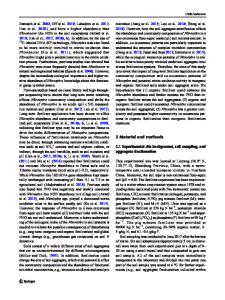Occurrence and partitioning of brominated flame retardants (BFRs) in indoor air and dust: a 15-month case study in a tes
- PDF / 438,913 Bytes
- 11 Pages / 595.276 x 790.866 pts Page_size
- 36 Downloads / 305 Views
RESEARCH ARTICLE
Occurrence and partitioning of brominated flame retardants (BFRs) in indoor air and dust: a 15-month case study in a test home Jia-Qi Guo 1,2,3 & Yong-feng Li 4 & Li-Yan Liu 1,2,3 Yi-Fan Li 1,2,3,5
&
Chun-Yan Huo 1,2,3 & Yu Sun 1,2,3 & Wan-li Ma 1,2,3 & Zi-feng Zhang 1,2,3 &
Received: 16 December 2019 / Accepted: 17 June 2020 # Springer-Verlag GmbH Germany, part of Springer Nature 2020
Abstract Ten polybrominated diphenyl ethers (PBDEs) and 16 novel brominated flame retardants (NBFRs) were measured in air and dust samples collected in a test home in Harbin, China, from January 2017 to June 2018. The PBDE and NBFR concentrations in indoor air were in the ranges of 0.598–14.5 pg m−3 and 9.28–686 pg m−3, respectively. The ranges of the PBDE and NBFR concentrations in indoor dust were 221–1060 ng g−1 and 71.9–1160 ng g−1, respectively. Brominated flame retardant (BFR) concentrations in indoor air were affected by the temperature, relative humidity (RH), and ventilation. The BFR concentrations in indoor dust did not show temperature dependence. All dust samples were sieved into 6 size fractions (F1–F6: 1000–2000 μm, 500–1000 μm, 250–500 μm, 125–250 μm, 63–125 μm, and < 63 μm). The mass percentage of BFRs in F6 was the highest. The BFR concentrations did not increase constantly with a particle size decrease, and the concentrations in F2 were higher than those in F3. The partitioning behavior of BFRs illustrates that the dust-air partitioning coefficient approximately approached equilibrium within F5, F6, and the total dust fraction (FA) in the test home when logKOA was between 9.1 and 11.32. Air-dust fugacity fractions were calculated, and the results suggested that most of the BFRs were mainly transferred from air to dust in the indoor environment for F1–F6. Keywords PBDEs . NBFRs . Influence factors . Source analysis . Particle size . Dust-air exchange
Introduction Responsible Editor: Constantini Samara Electronic supplementary material The online version of this article (https://doi.org/10.1007/s11356-020-09788-9) contains supplementary material, which is available to authorized users. * Li-Yan Liu [email protected] 1
International Joint Research Center for Persistent Toxic Substances (IJRC-PTS), State Key Laboratory of Urban Water Resource and Environment, and School of Environment, Harbin Institute of Technology, Harbin 150090, China
2
International Joint Research Center for Arctic Environment and Ecosystem (IJRC-AEE), Polar Academy, Harbin Institute of Technology, Harbin 150090, China
3
University Corporation for Polar Research, Beijing 100875, China
4
School of Forestry, Northeast Forestry University, Harbin 150060, China
5
IJRC-PTS-NA, Toronto M2N 6X9, Canada
Polybrominated diphenyl ethers (PBDEs) and novel brominated flame retardants (NBFRs) are brominated flame retardants (BFRs) commonly added to commercial materials and consumer goods to reduce fire possibility. With the ban or restriction of commercial penta-, octa-, and deca-BDE, the market demand for alternative flame retard
Data Loading...











